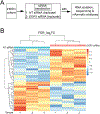Early growth response 1 transcription factor is essential for the pathogenic properties of human endometriotic epithelial cells
- PMID: 35679138
- PMCID: PMC9339520
- DOI: 10.1530/REP-22-0123
Early growth response 1 transcription factor is essential for the pathogenic properties of human endometriotic epithelial cells
Abstract
Although a non-malignant gynecological disorder, endometriosis displays some pathogenic features of malignancy, such as cell proliferation, migration, invasion and adaptation to hypoxia. Current treatments of endometriosis include pharmacotherapy and/or surgery, which are of limited efficacy and often associated with adverse side effects. Therefore, to develop more effective therapies to treat this disease, a broader understanding of the underlying molecular mechanisms that underpin endometriosis needs to be attained. Using immortalized human endometriotic epithelial and stromal cell lines, we demonstrate that the early growth response 1 (EGR1) transcription factor is essential for cell proliferation, migration and invasion, which represent some of the pathogenic properties of endometriotic cells. Genome-wide transcriptomics identified an EGR1-dependent transcriptome in human endometriotic epithelial cells that potentially encodes a diverse spectrum of proteins that are known to be involved in tissue pathologies. To underscore the utility of this transcriptomic data set, we demonstrate that carbonic anhydrase 9 (CA9), a homeostatic regulator of intracellular pH, is not only a molecular target of EGR1 but is also important for maintaining many of the cellular properties of human endometriotic epithelial cells that are also ascribed to EGR1. Considering therapeutic intervention strategies are actively being developed for EGR1 and CAIX in the treatment of other pathologies, we believe EGR1 and its transcriptome (which includes CA9) will offer not only a new conceptual framework to advance our understanding of endometriosis but will also furnish new molecular vulnerabilities to be leveraged as potential therapeutic options in the future treatment of endometriosis.
Conflict of interest statement
Declaration of interest
The authors declare that no conflict of interest could be perceived as prejudicing the impartiality of the research reported.
Figures








References
Publication types
MeSH terms
Substances
Grants and funding
LinkOut - more resources
Full Text Sources
Medical
Molecular Biology Databases

